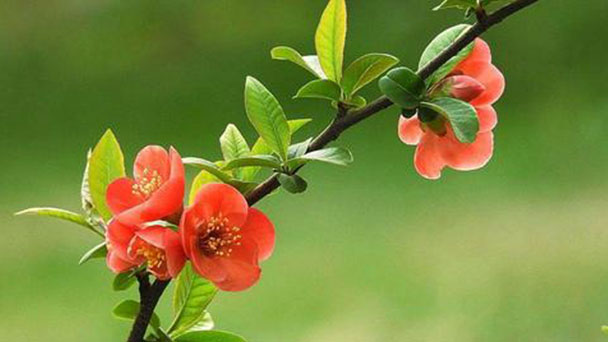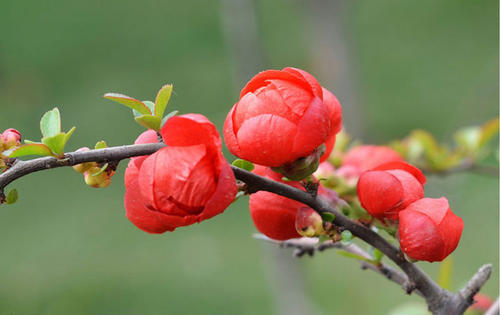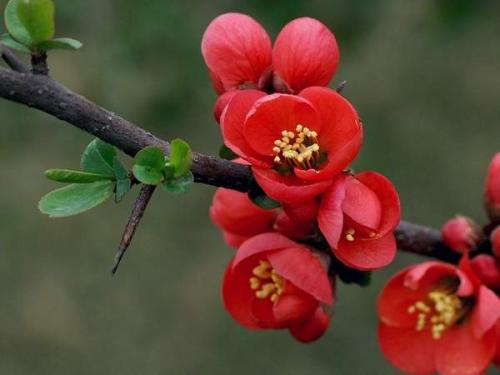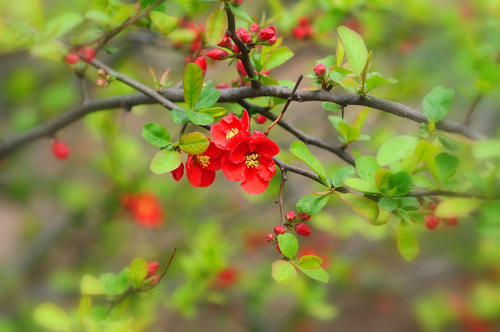Chaenomeles speciosa (flowering quince) profile
Written by Maggie
Feb 26 2021

Chaenomeles speciosa (flowering quince) belongs to the rose family plant, the fruit can be medicine, has the function of relaxing tendons, activating collaterals and moistening the stomach. Flowering quince has unique medicinal and health value and is reputed as "the fruit of one hundred benefits". The wrinkled papaya is also a unique solitary ornamental tree.Thick branches can be made green Gracilaria prickly. The fruit contains malic acid, tartaric acid, structural-rafters acid and vitamin C, etc. After drying, Flowering quince is used as medicine to drive away phoenix, relax tendons, activate collaterals, relieve pain.
Flowering quince picture

The morphological characteristics of Flowering quince
Shape
Flowering quince is a most deciduous shrub, up to 2 m tall, spiny; Branchlets are cylindrical, spreading, stout, purplish brown when tender, glabrous, dark brown when old.
Leaf
Flowering quince leaf blade is ovate to elliptic, sparsely elliptic, 3-10 cm long and 1.5-5 cm wide, apically acute, sparsely rounded and obtuse, base cuneate to broadly cuneate, margin sharply serrate, teeth spreading, surface slightly shiny, dark green, glabrous, abaxially light green, glabrous. Petiole of Flowering quince is 1-1.5 cm long, glabrous; Stipules are large, leaf-shaped, ovate or reniform, margin sharply doubly serrate, glabrous.
Flowers
Flowers of Flowering quince are 2-6 clustered on biennial shoots, 3.5-5 cm in diameter, open before or at the same time as leaves; Pedicels are stout, 3 mm long or nearly sessile, glabrous; Calyx tube is glabrous outside; Calyx lobes of Flowering quince are erect, subsemicircular, apex obtuse, entire or undulate teeth, margin with yellowish-brown eyelashes, glabrous outside, sparsely pilose inside, half of calyx tube long; Petals are suborbicular or obovate, short clawed, 1-1.5 cm long, scarlet or reddish; Flowering quince has 35-50 stamens, erect, 1-1.3 cm long, filaments microstreaked red; Style is connate below middle, glabrous, subequal to stamens, stigma capitate.
Fruit
Flowering quince globose to ovate, 3-5 cm in diameter, yellow or yellow-green, with inconspicuous sparse spots, aromatic, short or nearly absent fruit stalks.
Flowering quince ecological habits
Flowering quince is light loving, tolerant of cold, not tolerant of flooding and does not choose soil, but prefers fertile, thick and well-drained soil. Most flowering quince is a deciduous shrub of the family Rosaceae and genus Papaya. Flowering quince may grow to 2m in height, with 3 to 5 flowers growing in clusters on 2-year old branches. The flowers are red, pink and white, with a diameter of about 3 cm to 5 cm.Fruit ovate to globose, 4 cm to 6 cm in diameter.
Flowering quince growing methods
Plant management
The adaptability of Flowering quince is particularly strong, and the sex likes sunshine, can withstand drought, barren and high temperature, sloping land, hills, valleys, terraces and house before the yard after all suitable for planting. Especially in the sandy loam with pH value ranging from 6.5 to 7.5, because of the deep soil layer, loose texture, rich organic matter content and good drainage, the trees grow well and the yield is high. Flowering quince is best to cultivate in Kanbian, and it is convenient to harvest fruit.
Due to the small canopy in the early stage and the large space between plants, ginseng, Panax notoginseng, American ginseng, bamboo ginseng, a plant on the top of the head, a bowl of water by the river, a flower of chestnut leaves, anistia lotus and other medicinal materials or low-stem crops can be interplanted, so as to improve the land utilization rate.
Hoe weeding
Papaya garden is the most taboo grassland, once there are weeds breeding, must be removed in time. The soil loosening around papaya trees should be carried out in spring, and the first weeding should be carried out. The second weeding is in summer, and the mature trees should be weeded and loosened when weeds are easy to grow. Chemical herbicides should not be used more than twice a year, and straw and weeds can be covered in tree troughs during the growing season.
Installment fertilization
Flowering quince fertilization to phosphorus, potash fertilizer, with the combination of soil weeding, spring by 10kg/ plant compost, autumn fertilization by 15kg/ plant water manure or plant ash, to dig 10cm deep ditch around the tree at 70cm, immediately after the fertilizer cover, in order to prevent freezing winter soil should be built. The basic principle of fertilization is to apply more trees and less trees, generally 2~3 times a year fertilization.
Trim the training
When a Flowering quince is mature, it must be pruned to ensure a good harvest. Dry branches, dense branches and withered old branches should be in winter when the branches and leaves wither and spring sprout before pruning, let the tree into the inner empty circle coronal shape, after pruning, fertilization 1 time.
Water management
In terms of water, Flowering quince does not have high requirements, and it has a strong drought resistance. Under normal circumstances, Flowering quince can be irrigated before and after flower bud initiation and during fruit expansion. In the season of abundant rainfall, drainage must be timely, effective prevention and control of root rot, antifreeze water should be combined with basal fertilizer irrigation 1 times before winter.

Flowering quince area of distribution
Flowering quince is grown in Shaanxi, Gannan, Henan, Shandong, Anhui, Jiangsu, Zhejiang, Jiangxi, Hunan, Hubei, Sichuan, Guizhou, Yunnan, Guangdong and other provinces in China. Flowering quince is cultivated throughout the country.
Flowering quince is also found in Myanmar, Japan and Korea.
Flowering quince is mainly cultivated in Jiangsu, Zhejiang, Anhui, Hunan and other provinces.
Green quince disease control
Flowering quince is likely to be damaged by diseases and insects during the growth process of quince, which often results in early leaf shedding, fruit deformity, weakened growth potential, and reduced ornamental value, thus causing difficulties in conservation and management. According to the author's investigation over the past three years in Jiangsu, Zhejiang, Shanghai and Anhui provinces, mainly in Suzhou and in eastern China, Flowering quince was found that there are mainly one or two diseases and insect pests that occur all the year round during the adult stage, which cause serious damage and must be controlled carefully, namely, begony rust, sphincter bug and aphids.
The occurrence and damage characteristics of main diseases and insect pests of Malus SPP. : In the early stage of Malus SPP., small yellow-green spots appear on the front of the Flowering quince leaves, which gradually expand to orange yellow spots later. On the front of the spot, there are pinpoint-sized black small dots, and on the back of the leaf, there are hard yellow whiskers, which are the rust spore organs of the pathogen.In the late stage of the disease, the yellow whiskers became darker and gradually matured and powdered, and the adaxial lesions of the leaves expanded to form dark brown necrotic spots, which could be peeled off into perforation.
Flowering quince propagation
Sowing propagation can obtain a large number of neat seedlings, but it is not easy to keep the original variety characteristics. If the mother plant of Flowering quince is excavated and divided into 2 to 3 branches per plant in autumn or early spring with strong tiller capacity, it may be divided into two or three branches per Flowering quince. Three years after planting, Flowering quince may be divided. It is usually planted in autumn to promote wound healing. Flowering quince can be planted in the following spring and flowering in the following year. Hard cuttings and the same period, in the growth season can also be tender plant cuttings, will be about 15 cm long plant segment, inserted in the sand or soil, water and moisture, after more than a month can hair leaves.Cutting seedling 2 years to 3 years can blossom.
Flowering quince garden use
Park, courtyard, campus, square and other roads can be planted on both sides of the wrinkled papaya tree, graceful, flowers and flowers, can if Yunjin, fragrance overflowing, the effect is very good. The Flowering quince as a unique solitary ornamental tree or three to five clusters of embellishment in the garden or garden green space, can also be cultivated into a dry or dry tree shrub as a piece of forest or garden embellishment; Spring flowers summer and autumn fruit, quietly elegant qiao show, colorful, people never tire of watching, please them. Flowering quince can produce a variety of shapes of bonsai, bonsai is known as one of the eighteen bachelor. The Flowering quince bonsai can be placed in the hall, flower table, porch corner corner, leisure site, can be matched with the building reasonably, so that the garden scenery times add style, is embellished more elegant and delicate.

Latest Updated
- Benefits of Bugleweed - 7 Science-backed Health Benefits
- Bugleweed Dangers & Side Effects - Is It Poisonous?
- How to Plant Evergreen Trees - What You Should Know
- When to Plant Evergreens - Grow Guide for Evergreen Trees
- 12 Wonderful Evergreen Shrubs for Your Garden
- 12 Popular Evergreen Plants with Pictures for Beginners
- When And How To Prune A Lilac Bush Like a Pro
- How to Grow & Care for Lilac Vine (Hardenbergia Violacea)
- Japanese Lilac Tree (Syringa Reticulata) Care & Propagation Guide
- Shumard Oak Pros and Cons - What to Know
Popular Articles
- Winter maintenance of Antirrhinum Majus
- How to Grow Terminalia Mantaly Tree
- How to Grow and Care for Crossostephium Chinense
- How to grow Antirrhinum Majus in spring
- Peristeria Elata (Dove Orchid) Profile: Info & Care Guide
- Underwatered Snake Plant (Sansevieria Trifasciata) - Signs And How To Fix
- How to Care for Brazilian Jasmine Plant (Mandevilla Sanderi)
- How to Grow & Care for Graptopetalum Purple Delight in Summer
- Rosa Chinensis (China Rose): Plant Growing & Care Tips
- How to Care for Baby Sun Rose (Aptenia Cordifolia)